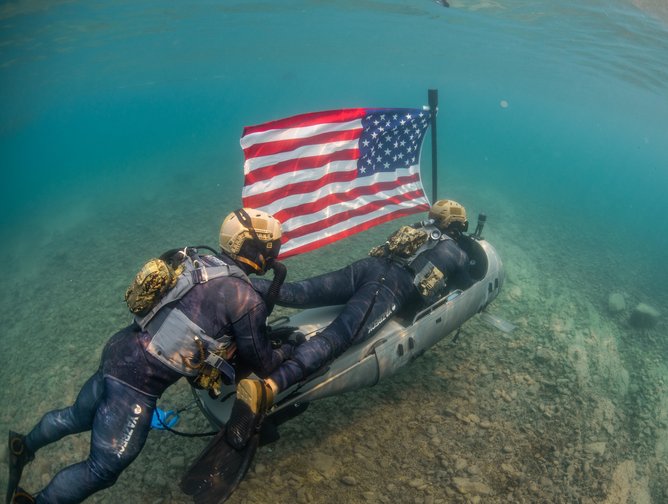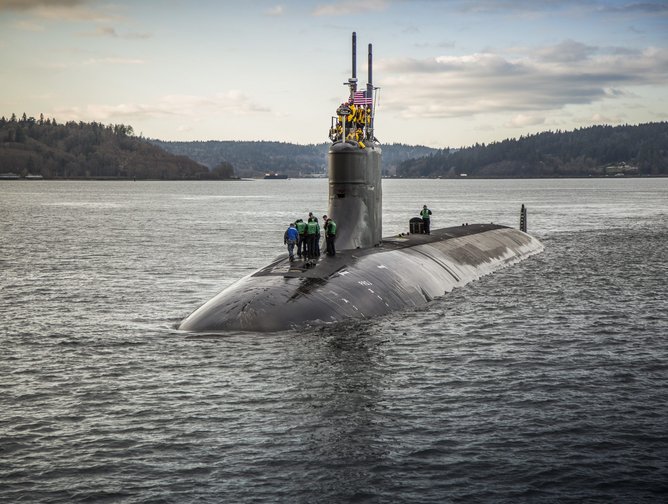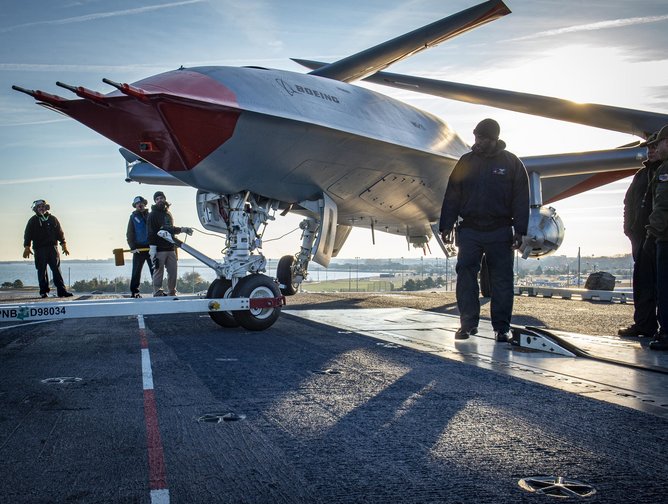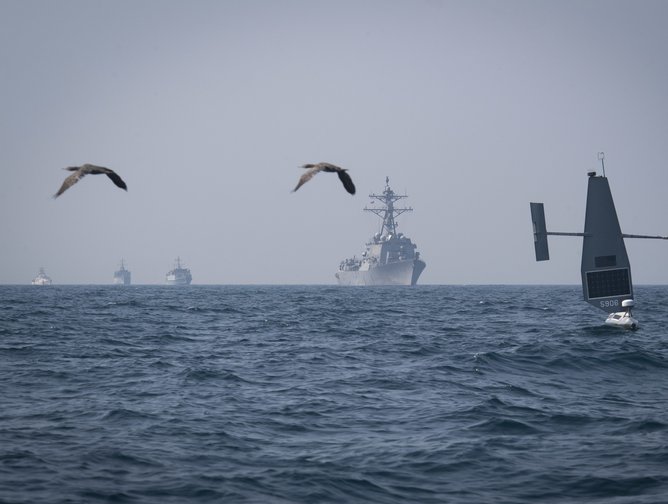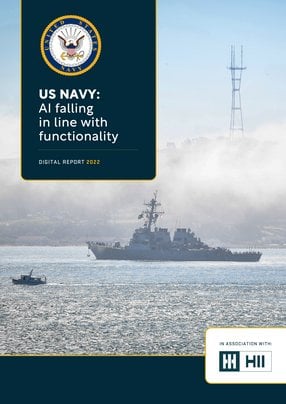If Hollywood were reality and depicted the use of AI within the US Navy, it would no doubt be a certified blockbuster.
While art often imitates life, the use of AI within the US armed forces is still an evolving space. Rapidly advancing technologies, which have the potential to convey increased capability also convey challenges. This challenge space, for the US Navy, belongs to Mr. Brett Vaughan.
Chief AI Officer for the US Navy, Brett Vaughan has been involved with security, defence and the military applications and implications of AI across several years. Although he modestly states that his greatest skill lies in communicating with various departments about the benefits of AI rather than the nuts and bolts of its coding, he is clearly a leading, global authority on the benefits of this cutting-edge technology within the defence and military space.
A civilian who originally qualified as a cartographer but went on to cut his teeth in military intelligence at the Pentagon, Vaughan is no stranger to balancing the potential of AI with the strictly classified protocols of military management. “It’s an expansive role. It essentially means I'm part ambassador, strategic communicator, and architect for AI for the service. My purview spans our Navy's war fighting capabilities, our readiness, our corporate activities, and our training and education as they relate to AI. Essentially anywhere the service is interested in designing, developing, or deploying AI-enabled activities or capabilities, that falls in my job jar.”
How AI capabilities have developed in the US Navy
There’s a long history of cutting-edge technology use within the US Navy. According to Vaughan, the Navy's experience with AI goes all the way back to the discipline’s inception in the 50s. The bulk of the US Navy’s experience in AI from then until now has been predominantly in the research and development (R&D) arena. During that time, US naval technologists established themselves as global leaders in terms of their expertise in the field of AI.
“We established a Navy Centre for AI Research at the Naval Research Lab in 1981,” says Vaughan. “And today, if you went to find our AI rockstars, our geniuses within the Navy community, that's where you'd find most of them; however, I think many would be surprised to find AI activity in almost every sector of the service.”
Currently, the US Navy is actively designing and developing over 1000 AI-related activities. “I think most would be surprised to the degree with which AI is being groomed and developed within the Navy,” Vaughan confirms. “But, a majority of those efforts reside in the R&D realm, and so in the highly-technological and competitive landscape of the modern era we are prioritizing the accelerated progression of those capabilities to the fleet.”
Military applications of AI
While Vaughan is limited in terms of the information he can impart on the Navy’s many AI projects, he is able to offer a broad perspective, including some of its use case areas. He says there are two areas where AI predominantly manifests within the US Navy: “AI enables a certain level of autonomy in unmanned/robotic systems (drones to most) and also fuels a wide array of decision aids, designed to augment, improve and speed human decision-making.”
Improving human performance across the board is a very apt description of the US Navy’s aim for AI. Improving safety, elevating operational and corporate efficiency and reducing risk are hallmarks of this approach. The Navy’s accelerated adoption of AI, explains Vaughan, requires not only technical acumen but also a non-negotiable focus on the human aspects of AI development and deployment, with specialists constantly honing and improving the AI-enabled capabilities. The goal is to consistently improve functionality and safety for human personnel, as well as provide operational commanders with broader options of capability. “Thus, for example, instead of deploying an all-manned force for a particular operation or function, that commander may be able to weave in autonomous /robotic systems into his/her capability mix; what our Chief of Naval Operations calls a “hybrid fleet.”
But it's not all about frontline operations. There are, notes Vaughan, many practicalities that can be served in terms of the operational management of the US Navy. This is especially true when it relates to manual labour. “It’s what we call the dull, dirty and dangerous, like scraping barnacles off the hulls of ships, or painting ships, or defusing mines, or jobs like that. I'm positive any sailor that has the job of scraping barnacles off the hull of a ship would love to be relieved of that task by a robot. And we have those today. Crawling inside the hull of a ship looking for corrosion is another – you go deep down in a ship, and that's not a very hospitable environment. Machines can in many cases do that quicker, and more effectively, than humans.” I like to think of this as a great example where the US taxpayer is getting a much better return on their investment and the Navy increases efficiency at a stroke.
Another area where AI is being deployed is in decision aids, where humans are assisted in making better and faster decisions. Citing these use cases, Vaughan says: “It might be a ship’s navigator, or radar operator underway in the middle of the ocean, or it might be a budget analyst in the Pentagon trying to resolve financial figures. The applications of AI in that context of decision aids are almost infinite and we are giving that potential wide address.”
“In both of those applications, whether it's decision aids or autonomy, we approach AI development as very problem-specific and context-dependent which drives us to put a premium focus on the inclusion of our core user base, our warfare enterprises, in the design of AI capabilities. That means undersea warfare, surface warfare, aviation, special operations (our Navy SEALs), information and expeditionary warfare – all have AI-enabled autonomy and decision aid applications, platforms, and uses.”
And so whether drones or decision aids, a focus on the human element is paramount in the US Navy pursuit of AI capabilities.
Integrating AI into the military culture
Despite the fact that the US Navy has been investigating the potential of AI for the past 50 years, the practical application and integration of the technology has been challenging. Industry, not the federal sector, are at the van of AI deployment today and industry models for AI adoption don’t always readily translate to the military. We truly live in a digital era dominated by software. Most companies today are either born digital or can rapidly adopt software-focused competencies; the US Navy is 247 years old and is challenged to make the transit to a more digital organization; however, it is a transit that we must make, says Vaughan, if we are to effectively leverage AI.
The process of developing and deploying AI in this manner is a departure from an institution with an largely industrial legacy and underpinned by practicality, he explains. “Writing requirements for those digital capabilities is one of those challenges, because we've been writing them for industrial purposes for decades, designing, building and operating planes and jets and submarines; hardware. Now, we have to think, talk and act to enable and deploy software; to write, deploy and sustain code to generate the right type of AI capabilities at the appropriate rate and nature of operation.”
It’s a cultural issue that requires careful and strategic handling – a hard task in an environment that, as Vaughan says, simply wasn’t born digital. “If you're a company in Silicon Valley today, chances are that you're born digital; knowing, out of the cradle, how to write software. You know how to check it. You know how to deploy it. You know how to tune it, maintain it and you know how to refresh it and everything that implies. These are new skill sets for the Navy, relatively speaking. So upskilling our sailors and marines to the point where they're more adept at those digital skills, but especially AI, is one of our greatest challenges today.”
Technical training and the war on talent
AI training within the US Navy is facilitated by the Navy Education Enterprise, which is, the Navy Community College, the Naval Academy in Annapolis, the Naval War College in Newport, and the Naval Postgraduate School in Monterey, California. Plans are in work to increase AI-related training and education at every one of these centers with the aim of upskilling the fleet and force of today and tomorrow to assure relevance and pacing of technologic development and advantageous position within the geopolitical landscape.
This push to ensure state-of-the-art training and education in AI has never been deemed as critical nor as timely as it is today. According to the final report of The National Security Commission on AI – an organization chartered by the US government to “to consider the methods and means necessary to advance the development of artificial intelligence, machine learning, and associated technologies to comprehensively address the national security and defense needs of the United States.” - we are now in an age of AI deployment and they have recommended to the US President and Congress that the US Defence Department be AI-enabled by 2025.
Mr. Vaughan bears prime responsibility in helping the US Navy reach that goal. The Navy strategy to achieve AI enablement by 2025 is critically dependent on people and upskilling today’s fleet and force to compete in cyber space while advancing the aims of the service and the nation. That strategy is in constant tension with the global marketplace and the demand for digital skills. But as careers continue to evolve from ‘jobs for life’ into more transient positions, the war on talent is a wholly different battle for the Navy to address.
Vaughan says: There are offsetting forces at play here. The US Navy offers a sense of mission and duty over that of the commercial sector. It also offers intriguing opportunities to access and tackle challenging operational problems; this is catnip to the AI community. Industry on the other hand can offer financial incentives that the government cannot match and so yes it is natural to see talent coming in, moving across and sometimes out at a rate that is more dynamic than what we are accustomed to.
A valuable constant in this equation is the military reserves. Thankfully, because of the ability for former full time military personnel to become reservists, talent is still retained to a degree. Nevertheless, it's a challenge to be dealt with. “A lot of them, even if they do leave the US Navy, remain reservists and that talent and expertise come back at some point. We keep that pipeline open to be able to recapitalise that experience – the door is always open to welcome them back and leverage their skills as reservists.
“If I walked into the Pentagon today and ran into a junior officer that was wearing the Navy uniform, and he told me he could code artificial intelligence, nine times out of 10 that person's going to be a reservist. That means they work at Amazon, or at Google, or Microsoft in their civilian jobs and they're a navy reservist in uniform. So I can't overstress or emphasise the importance of the reserves to our strategy, our designs, and our plans for AI.”
It’s worth remembering that the US Navy also has a strong civilian cadre – Vaughan himself isn’t a member of the military – and that means lots of people within the organisation are using their industry-learned skills to transform military operations, too. “On the civilian side, I think we're in terrific shape. Our information warfare community has done a terrific job over the last decade of creating and sustaining a vibrant pipeline of civilians that flow into the Navy with what we call critical AI skill sets, like computer science, statistics, mathematics, data science, data engineering, AI and ML ops.”
He says that now, an important part of AI workforce strategy is elevating the uniformed ranks to a similar level of parity. “We're actually today in the process of developing a robotics rating within the Navy enlisted corps, which will be huge. From there, it grows into ‘how do we advance the Navy rating system to address things like data science and data engineering?’ – which are skill sets core and critical to effective AI deployment. When we talk about moving something from, say, the lab to the fleet or the field, data engineers are paramount. That's one skill set that we're really keen to increase the numbers on.”
A timeline on developing AI solutions
The recommendation of the National Security Commission on AI and the mandate that “...by 2025 the foundations for widespread integration of AI across DoD must be in place...” has introduced a heightened importance on time as a factor in the US Navy’s AI calculations. This is a daunting goal from any perspective, and, according to Vaughan, necessitates an expansive adoption strategy across a broad range of disciplines.
It’s a challenge – and, with only three years to go until the deadline, there’s still much work to be done. “The clock is ticking; and it’s a very short game clock. We have to rapidly and broadly progress to an elevated posture that is conducive to delivering AI at speed and scale, and all the services have that challenge.”
But scaling itself is tricky, he explains. “The algorithm we build for a submariner is going to be different from the one we build for a jet pilot or somebody on a surface Navy ship. They are different environments and have different data; the transport layers are different; the operations are different. All those elements comprise the ecosystem you need to deploy AI effectively, so it's very important that you tune AI development within the intended use mission or problem set. At the same time you don’t want to get pigeon-holed or siloed in AI approach; you want to be able to extend AI-enabled solutions across the enterprise. In order to bridge this space, to effectively craft AI for the warfighter while setting conditions for broader exploitation, the US Navy has established AI Task Forces in every one of its warfare enterprises. An accomplishment that Vaughan is especially proud of especially as it provides purchase on the cultural challenges of AI adoption.
Scaling AI means that “If somebody has developed AI capabilities, say for submariners, I can now take that solution and extend it to other pieces of the enterprise and potentially boot-strap other warfare enterprises as well. Scaling means efficient recapitalization; not re-inventing the wheel every time you develop an AI pipeline or a piece of code, you can leverage or recapitalize that work across the enterprise.”
Vaughan says that it's essential to have the team skilled enough to undertake the task. But that team must also have a viable, resilient and robust digital fabric underneath. He points out that AI is very heavily reliant on compute, such as cloud and high-performance compute assets, transport layers, and the network.
“You have to move ones and zeros around from where they're collected to where they need to be processed, to a decision maker or to a robotic system. All of that substrate needs to be in place, ready and resilient, so there’s a great deal of work ahead of us,” he concedes but maintains confidence that the critical benchmarks will be met.
AI, Robotics and the front line
As the field of robotics and AI steadily advances, the use cases increase. Robots already replace humans in several sectors across industry, from manufacturing to medicine. Elon Musk has also recently unveiled his first humanoid robot. So, where does the field of robotics fit in when it comes to the military? Will we be seeing a not-too-distant future filled with soldier bots – or their equivalents?
On this point, much speculated over the years, Vaughan is noncommittal – but he is happy to frame the conversation in terms of frontline implications.
“I think the most apt characterisation is, in a word, “hybrid.” An operational environment where robots and AI decision aids augment the human, not replace them,” he says, explaining that, although the Hollywood version of AI soldiers is not yet reality, the core technology is certainly in play and its potential increases every day. “Our operational focus for the accelerated and impactful deployment of AI centers on how we Defend, Maneuver, Resupply and Shoot (Navy fires).”
An achievable deadline
Frontline battle tech aside, the priority right now is to hit the 2025 AI-enablement deadline, as set out in the five-year plan by the US President and Congress.
Ultimately, says Vaughan, it's about code, coding and more coding – and then it’s all about the manner of delivery. “Whether it's the application, the development, or the practice of how you write code, how a sailor or marine works with technologists to make sure the code is both correct and effective, or how you deliver it to a warfighter or a user – and then how you tune it, sustain it and ensure it's running properly and within desired parameters – all those are part of what we would call the AI tradecraft or competency.”
“So, if there's any bumper sticker here, that is probably it: the Navy treats AI as a competency. Done right it’s a harmonious synthesis of human and technologic elements. I think that's important, because a lot of people get fixated on AI as a technology and lose the human element when that is precisely the goal of AI, at least for the US Navy. It takes good, human-focused practice and skills to do it right and deploy it effectively.”
